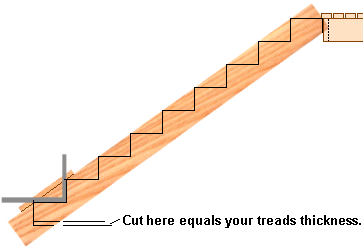 |
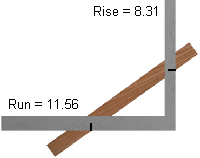 When you've decided
on a size, clamp a straight stick to a steel square with C clamps at the sizes your run
and rise will be. After tracing the square for the first run and rise, slide the square
along the stringers edge for the next set. After all the steps are drawn you'll need to
cut the bottoms off the stringers where they sit on the floor. This cut allows the
stringer to drop down the thickness of your treads so the first step won't get higher
when its tread is added. When you've decided
on a size, clamp a straight stick to a steel square with C clamps at the sizes your run
and rise will be. After tracing the square for the first run and rise, slide the square
along the stringers edge for the next set. After all the steps are drawn you'll need to
cut the bottoms off the stringers where they sit on the floor. This cut allows the
stringer to drop down the thickness of your treads so the first step won't get higher
when its tread is added.
If you're planning on attaching riser boards, they close off the fronts of the steps so you don't see under the steps, determine if you need to make the top most run longer to compensate for the riser boards thickness. The top riser board may or may not consume some of the top steps width depending on whether or not the stringer attach area is already faced or if you'll be adding a board there too. |
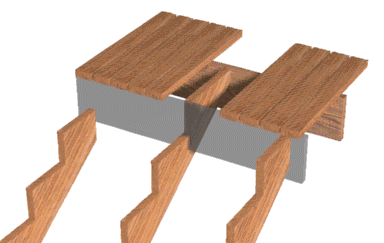 I usually just use the square for the first stringer, then cut and trace it for the remaining stringers. This will guarantee the stringers are all the same length, which isn't always the case after sliding the square along so many times. |
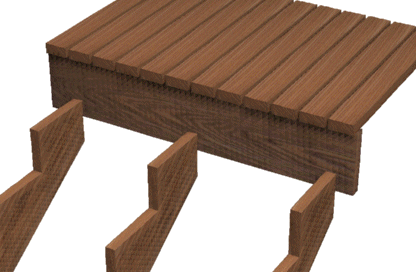 This is perhaps the
most dangerous way a stringer could be fastened. Notice how easily the stringer could
split with so little bearing against something solid. This has been a very common way of
building when a better way isn't known. I've often seen this done and cringe when I do
knowing it's an accident waiting to happen This is perhaps the
most dangerous way a stringer could be fastened. Notice how easily the stringer could
split with so little bearing against something solid. This has been a very common way of
building when a better way isn't known. I've often seen this done and cringe when I do
knowing it's an accident waiting to happen |
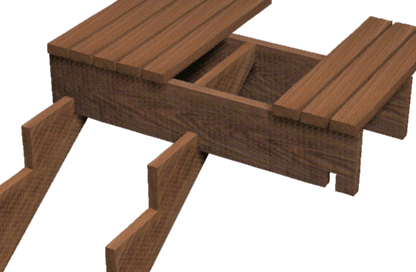 When the upper step
can't be flush with the landing, the stringer should be built longer so it can pass
behind the face board to a suitable mounting position. This method usually requires the
face board to be notched to allow the stringer to pass through. This way of mounting a
stringer does requires a longer stringer and somewhat weakens the face board, but is much
preferred to the previous method. When the upper step
can't be flush with the landing, the stringer should be built longer so it can pass
behind the face board to a suitable mounting position. This method usually requires the
face board to be notched to allow the stringer to pass through. This way of mounting a
stringer does requires a longer stringer and somewhat weakens the face board, but is much
preferred to the previous method. |
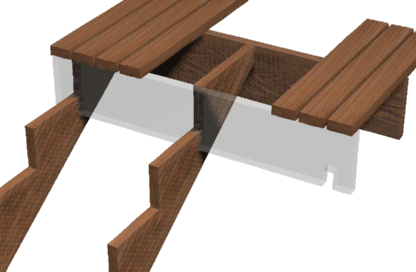 If you're planning
to use this arrangement in attaching stringers, be aware that you'll also need to cut the
stringers uppermost run a little longer where there is an interference with the face
board. This doesn't usually weaken the stringer substantially, but be cautious as you're
actually thinning the stringer slightly by cutting deeper through it. The run dimension
will need to remain the same as the others even though the run passes through under the
face board. If you're planning
to use this arrangement in attaching stringers, be aware that you'll also need to cut the
stringers uppermost run a little longer where there is an interference with the face
board. This doesn't usually weaken the stringer substantially, but be cautious as you're
actually thinning the stringer slightly by cutting deeper through it. The run dimension
will need to remain the same as the others even though the run passes through under the
face board. |
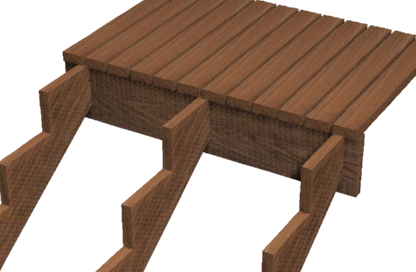 By far the
preferred method of attachment is as shown here in this example. The face board as well
as the stringer are not cut any more than necessary. The only real drawback is the top
stair tread being flush with the deck is causing the stair to be one tread longer in its
total length. This way of cutting stringers actually has the same number of rises as it
does runs. The other two stringer types have one less run than rise. By far the
preferred method of attachment is as shown here in this example. The face board as well
as the stringer are not cut any more than necessary. The only real drawback is the top
stair tread being flush with the deck is causing the stair to be one tread longer in its
total length. This way of cutting stringers actually has the same number of rises as it
does runs. The other two stringer types have one less run than rise. |